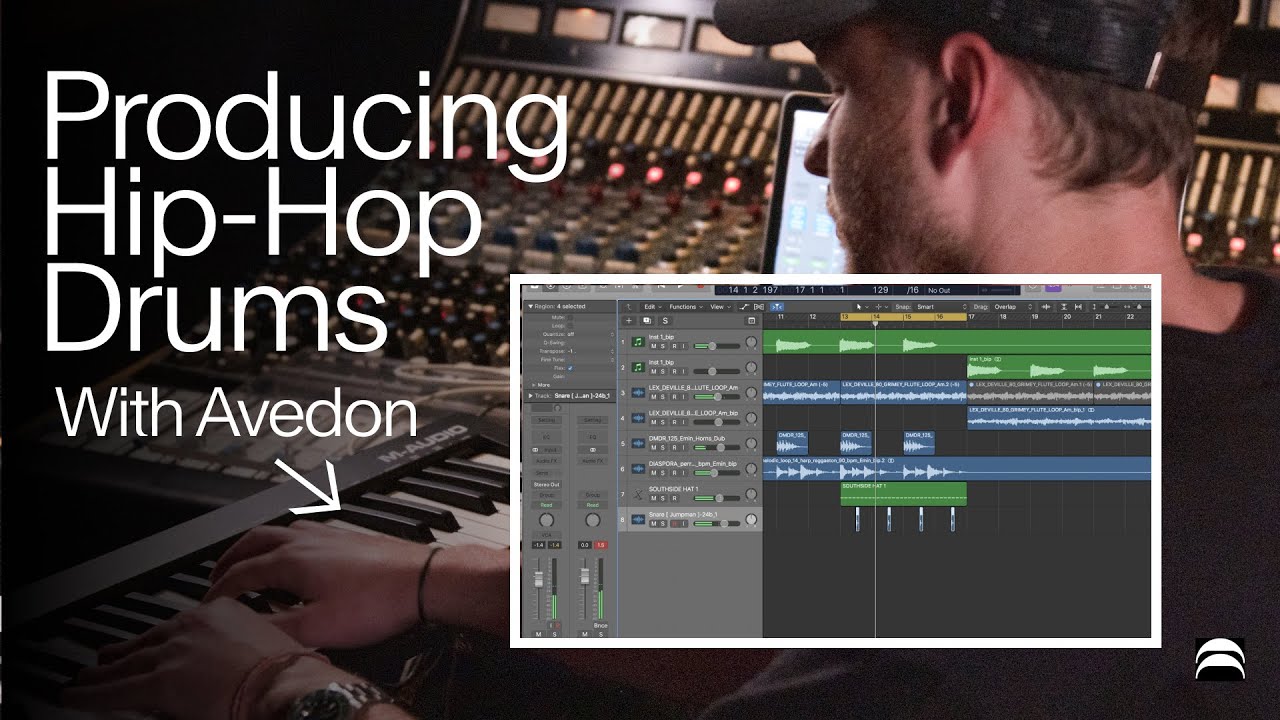Snare Drum with Cory Edwards of Elevation Worship
Summary
TLDRIn this detailed snare drum miking and processing tutorial, the speaker walks through the use of three microphones—two on the top and one underneath the snare—explaining their purpose for capturing the transient, body, and air of the snare sound. The video delves into phase adjustment, EQ carving to reduce boxiness and enhance low-end warmth, as well as compression settings to manage transients and extend the snare's noise. The speaker emphasizes the importance of balance between the top and bottom mics, while also ensuring a natural snare sound without excessive gating, offering a comprehensive insight into live drum sound engineering.
Takeaways
- 😀 The snare drum setup involves three microphones: an SM57 and DPA 2011 on the top, and a 414 on the bottom for capturing the snare's air and rattling.
- 😀 The phase of the bottom mic is flipped to align with the top mic, preventing low-mid frequency cancellations and enhancing the snare's overall sound.
- 😀 The top mic captures the transient and body of the snare, while the bottom mic adds air and emphasizes the snare’s rattling, essential for its distinctive sound.
- 😀 Snare mics are routed to a mono group, similar to the kick drum mics, for overall EQ processing, though they are processed individually first.
- 😀 EQ adjustments for the snare top mic focus on reducing boxiness around 2k Hz and cutting low-mid frequencies to improve clarity.
- 😀 The API 2500 compressor on the snare top mic is used with a semi-slow attack and short release to manage the transient and low-mid energy.
- 😀 For the bottom mic, EQ cuts are made at 7-900 Hz and some high-mid frequencies to avoid overlap with the top mic’s transient handling.
- 😀 The bottom mic is compressed using a fast attack and slow release to control its transient while allowing snare noise to remain present in the mix.
- 😀 The bottom mic’s noise is intentionally preserved, adding realism and capturing the full interaction between the snare and kick drum.
- 😀 High-pass filters are applied to both the top and bottom snare mics around 80 Hz to eliminate unwanted low-end interference from the kick drum or arena noise.
Q & A
Why does the sound engineer use two microphones on the top of the snare drum?
-The two microphones on the top of the snare drum, an SM57 and a DPA 2011 pencil condenser, are used to capture different aspects of the snare. The SM57 handles the main transient and body, while the DPA 2011 captures more air and additional detail.
What is the purpose of the bottom microphone (AKG C414) in this setup?
-The bottom microphone captures the snares' rattle and the air moving through the snare drum. It adds depth and a characteristic noise that is important for the snare to sound like a snare, rather than just another tom.
Why is phase alignment important between the top and bottom snare microphones?
-Phase alignment ensures that the low-mid frequencies do not cancel each other out when the two microphones are combined. Flipping the phase on the bottom mic helps to preserve the full, balanced sound of the snare drum, particularly in the low-end.
How does the sound engineer use EQ to process the top snare mic?
-The sound engineer uses EQ to reduce boxiness by cutting frequencies around 650-700Hz and 2kHz. Additionally, a slight boost around 140Hz is applied to add fullness to the snare, especially for modern worship music.
What role does the API 2500 compressor play on the snare top mic?
-The API 2500 compressor is used with a slow attack and short release to allow the snare's transient to pass through while adding some warmth and control to the low-mid frequencies, providing a more cohesive sound.
What specific sound is the engineer aiming for when using compression on the snare bottom mic?
-The engineer aims to reduce the transient impact of the snare bottom mic while extending the resonance and air of the snare. This effect enhances the natural snare sound, especially in its interaction with other drums.
Why does the engineer prefer not to gate the snare mics?
-The engineer prefers to avoid gating the snare mics in order to maintain the natural interaction between the snare and other drums. Gating could remove the organic noise that occurs naturally in the performance, particularly the interaction between the snare and kick drum.
What is the reasoning behind using high-pass filters on the snare mics?
-High-pass filters are applied to the snare mics (around 80Hz) to eliminate unwanted low-end rumble, such as noise from the kick drum and the PA system, ensuring that the snare drum’s sound is clean and focused.
How does the engineer balance the two snare microphones in the mix?
-The engineer starts by adjusting the top mic at unity gain and blends in the bottom mic until a balance is reached. The goal is to combine the body of the top mic with the air and noise captured by the bottom mic, creating a full and dynamic snare sound.
What is the benefit of routing the snare microphones to a mono group?
-Routing the snare mics to a mono group allows the engineer to apply overall EQ adjustments to both microphones simultaneously. This ensures that any issues in frequency balance are addressed without affecting the processing of each mic individually.
Outlines

このセクションは有料ユーザー限定です。 アクセスするには、アップグレードをお願いします。
今すぐアップグレードMindmap

このセクションは有料ユーザー限定です。 アクセスするには、アップグレードをお願いします。
今すぐアップグレードKeywords

このセクションは有料ユーザー限定です。 アクセスするには、アップグレードをお願いします。
今すぐアップグレードHighlights

このセクションは有料ユーザー限定です。 アクセスするには、アップグレードをお願いします。
今すぐアップグレードTranscripts

このセクションは有料ユーザー限定です。 アクセスするには、アップグレードをお願いします。
今すぐアップグレード5.0 / 5 (0 votes)






